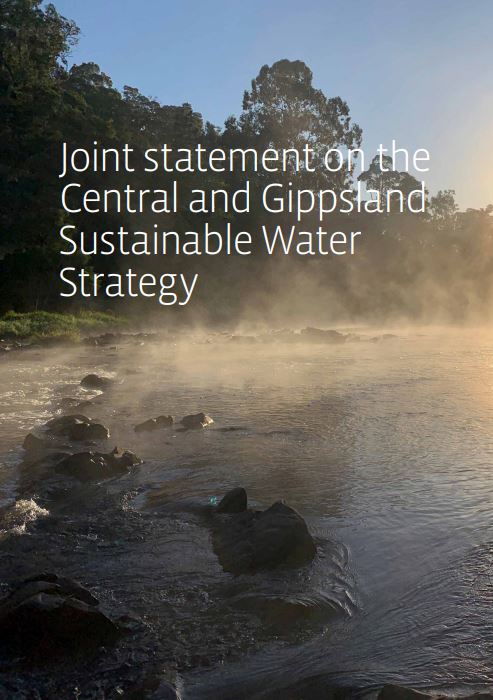SUSTAINABLE WATER STRATEGY
The Central and Gippsland Sustainable Water Strategy (SWS) is a strategic planning framework for southern Victoria, covering waterways and catchments south of the Great divide from Mallacoota to the Otways.
The Strategy will plan for ‘how we double our water supplies over the next 50 years … and must be reviewed after 10 years.’
Technical reports correctly identify that Southern Victoria is running out of water with less rainfall and inflows into rivers and recharge of aquifers. Consequently, water quality is poor and ecosystem health is suffering under a declining pool of water resources.
Please consider our analysis and engage with the strategy to give your feedback.
You can do so by either writing comments or a submission or taking a 5 minute survey.
A voice for the waterways
While this strategy has been prepared over 2 years, an alliance of community groups and environmental organisations came together in early 2021 to discuss concerns with the draft strategy and jointly responded to prior to the release of the draft in this Joint Statement outlining many of the community concerns.
Below you will find our analysis of the current draft strategy in relation to the Latrobe Valley and Greater Gippsland.

The Latrobe Valley and mine rehabilitation
All the technical reports identify a water crisis, yet the SWS does not reflect the severity, given matters of concern that have been omitted and which we know impact on water quality and quantity. Other matters of significance which contribute to poor water quality are considered with the proposed actions, treating a symptom and not the cause.
It is apparent that additional water gained for waterway health is contingent on an increase in use of recycled water from sewerage treatment plants. How will Gippslander’s feel about being recipients of Melbourne’s waste?
Despite the interconnectedness and overlap of many important issues, the SWS will only have relevance within the water department. Likewise, it does not influence cross-departmental policy direction, yet decisions made by other departments (related to planning, mining and agriculture) can cause the most negative impacts to streamflow and water quality.
Consequently, the SWS is open to interpretation that gives government scope to do whatever they want. This could prove costly and ultimately unsustainable as the strategy is flawed and developed in isolation, not as a whole government decision.
We also need to question what the long-term outcome is for the Latrobe Valley. The rehabilitation of Latrobe Valley coal mines is pivotal for determining future water supply for Melbourne and urban water security and plays a much bigger role in available allocations than what it is outlined in the strategy.
To put this in context, the current proposed options for filling mine voids with water include:
- Filling with recycled wastewater as proposed by the Latrobe Valley Regional Rehabilitation Strategy (LVRRS), with existing freshwater entitlements directed to Melbourne. Existing users retain their water rights, but the Latrobe River system is no better off – this is the current plan.
- Allow the freshwater entitlements to fill mines and the mines areas become assets for Gippsland. But the Latrobe River system is still no better off.
Greater Gippsland and the Implications
Essentially, the strategy is concerned with water quantity and quality. It is on these two criteria that we must consider the strategies effective worth for Greater Gippsland.
Below are the points that we have critiqued so far specific to Gippsland.
- There is no demonstrable understanding of emerging threats impacting water quantity and quality via over-extractions and/or discharging contaminants into our waterways which is a legislative requirements of Sustainable Water Strategies under Victoria’s Water Act 1989
- There is nothing binding in the SWS as there are no obligations backed by proposed legislation.
- While the strategy questions the impact of plantation harvesting on waterways, there is NO mention of mining in upper catchments from gold-mineral sands (not quarry) impacts on water quantity and quality.
- There are NO net increases in environmental flows for Latrobe River system which has consequences for the declining health of the Gippsland Lakes.
- The plan fails to identify land and water pollutant pathways from all sources and fails to outline how they would be effectively removed/reduced.
- The strategy promotes over-extraction of Gippsland Rivers through new irrigation rights. This is fundamentally unsustainable as all entitlement holders – including the environment’s entitlement – receive proportionately less when there is a drought.
- Whilst acknowledging the deep dredging of Lakes Entrance causes high salinity in the Lakes, the strategy only proposes to increase fresh flushes and not address the cause of the salinity. This is not sustainable as a solution in drought conditions.
- Traditional Owners will receive allocations contingent on greater recycled water uptake by others.
In general, the SWS lacks detail looking at individual issues which makes the draft strategy misleading and/or lacking target outcomes that would benefit from legislative changes for:
- Allocated and unallocated distinctions, including caps and using opaque
- Greater transparency in specific targets and pathways for returning water to river including how modelling guided decision making.
- Greater transparency on surface water accounting and all groundwater extractions needs to be fully accounted, e.g. Stock & Domestic bores.
- Urban water efficiencies have been given huge weight for very little return, clouding other major issues in Gippsland.
- Water quality and effluent breaches from agriculture are not addressed, rather the strategy mentions ‘land use changes/improvements’, leaving it open to interpretation and potential inaction.
- Interconnected water grid between Gippsland and Melbourne is lacking in detail and information.
- Misleading graphics.
- Completely ignores ongoing/offshore gas extraction depleting onshore aquifers and leading to saltwater intrusion into coastal aquifers.
The SWS is devoid of critical information needed to establish the foundation for good policy and decision-making.


